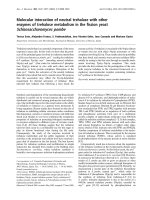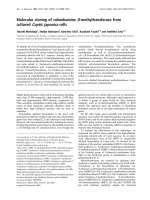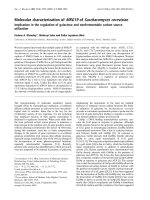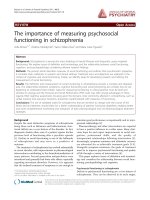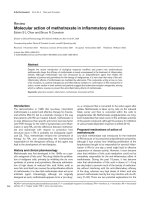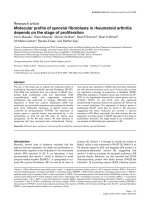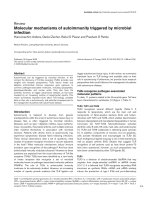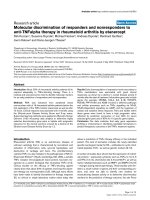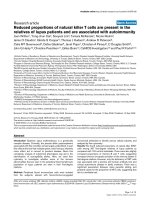Báo cáo y học: "Molecular targets of natural health products in arthritis" pps
Bạn đang xem bản rút gọn của tài liệu. Xem và tải ngay bản đầy đủ của tài liệu tại đây (134.34 KB, 3 trang )
Rheumatoid arthritis (RA) and osteoarthritis (OA) cause
enormous patient suff ering and economic burden. Due to
non-steroidal anti-infl ammatory drug (NSAID)- and
cyclooxygenase-2 (COX-2) inhibitor-associated ulcers
and cardiovascular adverse events, novel anti-arthritis
therapies are needed. Natural health product (NHP) use
by patients to alleviate symptoms is rising globally.
However, the quality of NHPs is poorly regulated and
their effi cacy, toxicity and mechanism(s) of action are not
understood. Using state-of-the-art approaches, Haqqi
and colleagues report in Arthritis Research and erapy
[1] that human chondrocytes expressed the p38-mitogen-
activated protein kinase (MAPK) isoforms p38α, -γ and
-δ, but not p38β. IL-1β enhanced phosphorylation of
p38α-MAPK and p38γ-MAPK but not of p38δ-MAPK.
ey showed by gene-silencing that p38-MAPK activa-
tion was mediated by mitogen-activated protein kinase
kinase 3 (MKK3). A standardized pomegranate extract
(PE) specifi cally diminished IL-1-induced and MKK3-
activated p38α-MAPK isoform and Runx2 (runt-related
transcription factor 2) activity. PE did not interfere with
the binding of IL-1β to IL-1 receptor, thus ruling out
steric hindrance as a suppression mechanism. PE also
inhibited JNK-MAPK and NF-κB activity.
p38, JNK-MAPK and NF-κB pathways are also major
targets of drug discovery in arthritis. e p38 cascade
regulates proinfl ammatory genes post-transcriptionally
but remains a controversial target due to modest effi cacy
and severe toxicity in clinical trials [2]. e NF-κB
pathway regulates cytokine and ADAMTS-4 genes, and is
an important therapeutic target in arthritis [3]. Activated
JNK and c-Jun constitute AP-1 factor, which enhances
synovitis in RA and matrix metalloproteinase (MMP)-
mediated cartilage loss [4]. Runx2 regulates induction of
collagen II-destroying human MMP-13 and aggrecan-
degrading, ADAMT S (a disintegrin and metallo protein-
ase with thrombospondin motifs) genes [5], whose inhi-
bi tion by PE could potentially reduce cartilage degrada-
tion. Runx2-defi cient (heterozygous) mice with surgically
induced knee OA displayed reduced cartilage destruc-
tion, osteophyte formation, type X collagen and MMP-13
expression (features of OA-associated aberrant hyper-
trophic chondrocyte diff erentiation) versus wild-type
mice [6]. us, benefi cial eff ects of PE may be through
these pharmacological targets.
Since the gastrointestinal tract may degrade the active
ingredients of NHPs, Haqqi and colleagues [7] demon-
strated that oral administration of PE in collagen-induced
arthritis mouse model protects joints from infl ammatory
arthritis. e chondroprotective eff ects of another PE
were reconfi rmed in the monoiodoactate-induced OA
model [8]. ese studies reveal molecular mechanisms of
PE action, including cartilage-protective active com-
pounds (polyphenols, ellagitannins, quercetin, gallic acid
and ellagic acid) that work through precise targets [7].
Abstract
Patients with rheumatoid arthritis (RA) and
osteoarthritis (OA) consume ‘natural health products’
(NHPs) whose therapeutic e cacy, toxicity and
mechanisms of action are poorly understood. In
a previous issue of Arthritis Research and Therapy,
Haqqi and colleagues characterized IL-1-activated
mitogen-activated protein kinase kinase 3 (MKK3)
and p38-mitogen-activated protein kinase (MAPK)
isoforms in human OA chondrocytes. The cartilage-
protective mechanisms of pomegranate extract involve
diminishing MKK3-activated p38α, JNK, NF-κB and
Runx2 pathways, which regulate in ammatory proteins
and cartilage-destroying proteases. Epigallocatechin-
3-gallate, resveratrol, curcumin and other NHP active
ingredients suppress multiple in ammatory and
catabolic molecular mediators of arthritis. Non-toxicity,
reduced severity and incidence of arthritis in animal
models warrant testing NHP active ingredients for
preventing human OA and RA.
© 2010 BioMed Central Ltd
Molecular targets of natural health products in
arthritis
Sarah Khalifé and Muhammad Zafarullah*
See related research by Rasheed et al., />EDITORIAL
*Correspondence:
Department of Medicine, University of Montreal and CRCHUM, Hôpital Notre-
Dame, K-5255 Mailloux, 1560 Sherbrooke est, Montréal, Québec, Canada H2L 4M1
Khalifé and Zafarullah Arthritis Research & Therapy 2011, 13:102
/>© 2011 BioMed Central Ltd
Considering the non-toxicity of PE in chondrocytes and
its eff ectiveness in RA and OA models, identifying
precise pomegranate active ingredients, their synergistic
eff ects and utility for preventing or reducing human OA
and RA through clinical trials is warranted. Epidemio-
logical studies on non-consuming and pomegranate-
consum ing populations for incidence of arthritis may
also be useful. One should also analyze potential
pharmaco logical drug-PE interactions.
e anti-arthritic eff ects of green tea are attributed to
the multiple activities of non-toxic epigallocatechin-3-
gallate (EGCG). It suppresses IL-1-induced glycosamino-
glycan release from cartilage by inhibiting ADAMTS,
MMP-1 and MMP-13 expression through preferentially
blocking NF-κB activity in chondrocytes. EGCG also
inhibits IL-1-stimulated inducible nitric oxide synthase
(iNOS), nitric oxide and JNK activities, which mediate
cartilage degradation. In RA synovial fi broblasts, EGCG
inhibits TNF-α-induced MMP-1, MMP-3, ERK (extra-
cellular signal-regulated kinase), p38, JNK and AP-1
activities. EGCG sensitizes RA fi broblasts to TNF-α-
induced caspase-3-mediated apoptosis by blocking Akt
and NF-κB cell survival pathways. EGCG also inhibits
IL-6 receptor-induced MMP-2, increases gp130 receptor
in fi broblasts and ameliorates adjuvant-induced rat
arthritis. EGCG suppresses osteoclast-specifi c, NF-ATc1
and RA-associated bone resorption and ameliorates
mouse arthritis. It inhibited oncostatin M-stimulated
CCL2 chemokine expression in human osteoblasts and
reduced severity of collagen-induced arthritis. ese in
vitro and in vivo studies suggest that EGCG could reduce
synovial hyperplasia, cartilage degradation and bone
resorption by modulating multiple targets in joints [9].
Despite its apparent safety in clinical trials of other
diseases, its potential for causing apoptosis in chondro-
cytes should be tested further.
Resveratrol from grapes displays anti-infl ammatory
and chondroprotective activities by increasing proteo-
glycan synthesis and chondrocyte proliferation and by
suppressing IL-1, reactive oxygen species, p53-induced
apoptosis, leukotriene B4, prostaglandin E2 synthesis and
MMPs in vitro [10]. Intra-articular resveratrol treatment
reduced cartilage loss in rabbit arthritis models.
Resveratrol induced fi broblast apoptosis but increased
chondrocyte survival by activating Sirtuin 1 (a histone
deacetylase) and Bcl2 [11,12]. us, resveratrol may
prevent intervertebral disc degeneration, OA-associated
infl ammation, chondrocyte apoptosis, and RA-related
pannus formation, desirable goals in treating OA and RA.
Resveratrol-like Sirtuin 1 activators are also being
developed as lifespan-extending drugs.
Curcumin suppresses infl ammatory and catabolic
mediators such as IL-1β-stimulated nitric oxide, prosta-
glandin E2, COX-2, IL-6, IL-8, MMP-3, MMP-9, JNK and
NF-κB activation and the oncostatin M-induced JAK/
STAT pathway in human chondrocytes [13]. It promotes
chondrogenesis from mesenchymal stem cells by antago-
nizing proinfl ammatory cytokines [14]. Despite these
anti-infl ammatory, antioxidant, anti-angiogenic activities,
its oral consumption and tissue bioavailability are
problem atic. Other NHPs, quercetin, triptolide and
silymarin, target infl ammatory cytokines, NF-κB, COX-2
and catabolic MMPs [15].
It is laudable that regulatory agencies are encouraging
research to substantiate the therapeutic claims by manu-
facturers of NHPs. We need well-controlled, molecular
and mechanistic studies on NHPs as modeled by Haqqi
and colleagues [1]. Currently, we can analyze multiple
targets of NHPs by gene arrays and proteomics to
evaluate their effi cacy in preventing and treating RA and
OA.
Abbreviations
ADAMTS, a disintegrin and metalloproteinase with thrombospondin motifs;
COX-2, cyclooxygenase-2; EGCG, epigallocatechin-3-gallate; IL, interleukin;
JNK, c-Jun N-terminal kinase; MAPK, mitogen-activated protein kinase; MKK3,
mitogen-activated protein kinase kinase 3; MMP, matrix metalloproteinase;
NF, nuclear factor; NHP, natural health product; OA, osteoarthritis; PE,
pomegranate extract; RA, rheumatoid arthritis; TNF, tumor necrosis factor.
Competing interests
The authors declare that they have no competing interests.
Acknowledgements
The work in our laboratory was supported by the Canadian Institutes of Health
Research.
Published: 3 February 2011
References
1. Rasheed Z, Akhtar N, Haqqi TM: Pomegranate extract inhibits the
interleukin-1beta-induced activation of MKK-3, p38alpha-MAPK and
transcription factor RUNX-2 in human osteoarthritis chondrocytes. Arthritis
Res Ther 2010, 12:R195.
2. Genovese MC: Inhibition of p38: has the fat lady sung? Arthritis Rheum
2009, 60:317-320.
3. Roman-Blas JA, Jimenez SA: Targeting NF-kappaB: a promising molecular
therapy in in ammatory arthritis. Int Rev Immunol 2008, 27:351-374.
4. Svensson CI, Inoue T, Hammaker D, Fukushima A, Papa S, Franzoso G, Schett
G, Corr M, Boyle DL, Firestein GS: Gadd45beta de ciency in rheumatoid
arthritis: enhanced synovitis through JNK signaling. Arthritis Rheum 2009,
60:3229-3240.
5. Thirunavukkarasu K, Pei Y, Moore TL, Wang H, Yu XP, Geiser AG, Chandrasekhar
S: Regulation of the human ADAMTS-4 promoter by transcription factors
and cytokines. Biochem Biophys Res Commun 2006, 345:197-204.
6. Kamekura S, Kawasaki Y, Hoshi K, Shimoaka T, Chikuda H, Maruyama Z,
Komori T, Sato S, Takeda S, Karsenty G, Nakamura K, Chung UI, Kawaguchi H:
Contribution of runt-related transcription factor 2 to the pathogenesis of
osteoarthritis in mice after induction of knee joint instability. Arthritis
Rheum 2006, 54:2462-2470.
7. Shukla M, Gupta K, Rasheed Z, Khan KA, Haqqi TM: Consumption of
hydrolyzable tannins-rich pomegranate extract suppresses in ammation
and joint damage in rheumatoid arthritis. Nutrition 2008, 24:733-743.
8. Hadipour-Jahromy M, Moza ari-Kermani R: Chondroprotective e ects of
pomegranate juice on monoiodoacetate-induced osteoarthritis of the
knee joint of mice. Phytother Res 2010, 24:182-185.
9. Ahmed S: Green tea polyphenol epigallocatechin 3-gallate in arthritis:
progress and promise. Arthritis Res Ther 2010, 12:208.
10. Csaki C, Keshishzadeh N, Fischer K, Shakibaei M: Regulation of in ammation
signalling by resveratrol in human chondrocytes in vitro. Biochem
Khalifé and Zafarullah Arthritis Research & Therapy 2011, 13:102
/>Page 2 of 3
Pharmacol 2008, 75:677-687.
11. Byun HS, Song JK, Kim YR, Piao L, Won M, Park KA, Choi BL, Lee H, Hong JH,
Park J, Seok JH, Lee YJ, Kang SW, Hur GM: Caspase-8 has an essential role in
resveratrol-induced apoptosis of rheumatoid broblast-like synoviocytes.
Rheumatology (Oxford) 2008, 47:301-308.
12. Takayama K, Ishida K, Matsushita T, Fujita N, Hayashi S, Sasaki K, Tei K, Kubo S,
Matsumoto T, Fujioka H, Kurosaka M, Kuroda R: SIRT1 regulation of
apoptosis of human chondrocytes. Arthritis Rheum 2009, 60:2731-2740.
13. Henrotin Y, Clutterbuck AL, Allaway D, Lodwig EM, Harris P, Mathy-Hartert M,
Shakibaei M, Mobasheri A: Biological actions of curcumin on articular
chondrocytes. Osteoarthritis Cartilage 2010, 18:141-149.
14. Buhrmann C, Mobasheri A, Matis U, Shakibaei M: Curcumin mediated
suppression of nuclear factor-kappaB promotes chondrogenic
di erentiation of mesenchymal stem cells in a high-density co-culture
microenvironment. Arthritis Res Ther 2010, 12:R127.
15. Khanna D, Sethi G, Ahn KS, Pandey MK, Kunnumakkara AB, Sung B, Aggarwal
A, Aggarwal BB: Natural products as a gold mine for arthritis treatment.
Curr Opin Pharmacol 2007, 7:344-351.
doi:10.1186/ar3222
Cite this article as: Khalifé S, Zafarullah M: Molecular targets of natural
health products in arthritis. Arthritis Research & Therapy 2011, 13:102.
Khalifé and Zafarullah Arthritis Research & Therapy 2011, 13:102
/>Page 3 of 3

